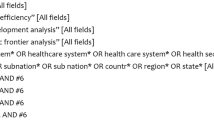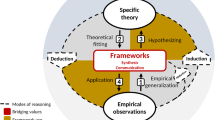Abstract
This article discusses evaluation of comprehensive cancer control efforts as developed in the United States by involved partners at all levels – community, regional, state, tribal, territorial, and national. Evaluation of comprehensive cancer control can concern the evaluation of a program, a plan or activities from a plan. In its development, it is grounded in both theory and practice, and the results are used in program development and implementation to document activities, inform decision making, and demonstrate accountability. Various types of evaluation have been shown to be important. Challenges to evaluating comprehensive cancer control include incorporating and working with a broad group of stakeholders; developing an agreed upon plan and evaluation, ensuring the necessary infrastructure for overseeing, facilitating, and disseminating results of evaluations; conceptualizing and communicating desired changes; and potentially implementing (and evaluating) programs at the community, regional, tribal, territorial, state, or national level. Using the CDC Framework for Evaluation, selected examples of state program evaluations are presented. These examples show the use of both process and outcome evaluations to illustrate programmatic improvement and the accomplishment of proposed objectives. As evaluation of comprehensive cancer control continues to be developed and results communicated, our ability to evaluate comprehensive cancer control programs increases and the growth of comprehensive cancer control efforts are encouraged.
Similar content being viewed by others
References
InstitutionalAuthorNameCenters for Disease Control and Prevention (2002) Guidance Document for Comprehensive Cancer Control Planning Department of Health and Human Services, Centers for Disease Control and Prevention Atlanta, GA 76
MQ Patton (1986) Utilization-Focused Evaluation Beverly Hills Sage Publications CA
Rootman I, Goodstadt M, Potvin L, Springett J (2001) A framework for health promotion evaluation. In: Rootman I, Goodstadt M, Hyndman B, et al., eds. Evaluation in Health Promotion: Principles and Perspectives. Geneva: World Health Organization, WHO regional publications, European series; 92, pp. 7–38.
Springett J (2001) Participatory approaches to evaluation in health promotion. In: Rootman I, Goodstadt M, Hyndman B, et al., eds. Evaluation in Health Promotion: Principles and Perspectives. Geneva: World Health Organization, WHO regional publications, European series; 92, pp. 83–105.
DL Stufflebeam (2001) ArticleTitleEvaluation Models New Directions Eval 89 7–99 Occurrence Handle10.1002/ev.3
TA Schwandt (2005) ArticleTitleThe centrality of practice to evaluation Am J Evaluation 26 95–105 Occurrence Handle10.1177/1098214004273184
D Grembowski (2001) The Practice of Health Program Evaluation Sage Publications Thousand Oaks, CA
LW Green MW Kreuter (1999) Health Promotion Planning: An Education and Ecological Approach Mayfield Publishing Company Mountain View, CA
RG Hollister J Hill (1995) Problems in the evaluation of community-wide initiatives JP Connell AC Kubisch LB Schorr CH Weiss (Eds) New Approaches to Evaluating Community Initiatives NumberInSeries1 The Aspen Institute Washington, DC 1–33
InstitutionalAuthorNameCenters for Disease Control and Prevention (1999) ArticleTitleFramework for Program Evaluation in Public Health MMWR Morb Mortal Wkly Rep 48 1–11
W.K. Kellogg Foundation (1998) Evaluation Handbook. As accessed on April 1, 2005, at: http://www.wkkf.org/.
W.K. Kellogg Foundation (2001) Logic Model Development Guide: Using Logic Models to Bring Together Planning, Evaluation, & Action. As accessed on April 1, 2005, at: http://www.wkkf.org/.
RC Granger (1998) Establishing causality in evaluations of comprehensive community initiatives K Fulbright-Anderson AC Kubisch JP Connell (Eds) New Approaches to Evaluating Community Initiatives NumberInSeries2 The Aspen Institute Washington, DC 1–16
InstitutionalAuthorNameInstitute of Medicine National Research Council (2003) Fulfilling the Potential of Cancer Prevention and Early Detection The National Academies Press Washington, DC
Raphael D (2001) Evaluation of quality-of-life initiatives in health promotion. In: Rootman I, Goodstadt M, Hyndman B, et al., eds. Evaluation in Health Promotion: Principles and Perspectives. Geneva: World Health Organization, WHO regional publications, European series, 92, pp. 123–147.
Author information
Authors and Affiliations
Corresponding author
Additional information
Thomas Chape-lThe findings and conclusions in this report are those of the authors and do not necessarily represent the views of the Centers for Disease Control and Prevention.
Rights and permissions
About this article
Cite this article
Rochester, P., Chapel, T., Black, B. et al. The Evaluation of Comprehensive Cancer Control Efforts: Useful Techniques and Unique Requirements. Cancer Causes Control 16 (Suppl 1), 69–78 (2005). https://doi.org/10.1007/s10552-005-0510-4
Received:
Accepted:
Issue Date:
DOI: https://doi.org/10.1007/s10552-005-0510-4




